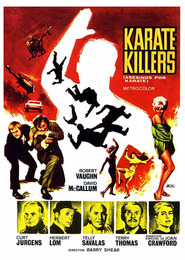The Karate Killers
| The Karate Killers | |
|---|---|
 |
|
| Directed by | Barry Shear |
| Produced by | Boris Ingster |
| Written by | Norman Hudis |
| Story by | Boris Ingster |
| Starring |
Robert Vaughn David McCallum Kim Darby Telly Savalas Herbert Lom Joan Crawford |
| Music by |
Gerald Fried Jerry Goldsmith (theme) |
| Cinematography | Fred Koenekamp |
| Edited by | William B. Gulick |
|
Production
company |
|
|
Release date
|
|
|
Running time
|
92 Min. |
| Country | United States |
| Language | English |
The Karate Killers is a 1967 feature-length film version of The Man from U.N.C.L.E.'s third season two-part episode "The Five Daughters Affair". The episodes were originally broadcast in the United States on March 31, 1967, and April 7, 1967, on NBC. It, as does the television series, stars Robert Vaughn and David McCallum. It is the sixth such feature film that used as its basis a reedited version of one or more episodes from the series. Joan Crawford,Telly Savalas,Herbert Lom,Diane McBain,Jill Ireland, and Kim Darby are among those in the cast. The film was directed by Barry Shear and written by Norman Hudis with the story by Boris Ingster.
The first four U.N.C.L.E. feature films made significant changes and additions to the episodes from which they were drawn. This movie, like the one immediately before it (“The Spy in the Green Hat”), makes relatively minimal changes to the episodes. No major scenes were added or removed, but various trims were made to fit the episodes into the running time of the film and musical cues and accompanying music was sometimes changed.
Also changed were some short scenes that became more violent or sexy than generally shown on American network television at the time. For example, both the dead bodies of Amanda True and Randolph are shown with eyes closed in the TV episode; in the movie, their eyes are open and Randolph’s death is more brutal. In some fight scenes, the movie version contains more violent images compared to the episodes (e.g., a bloody face in the London bar, greater violence in the Japanese temple). Margo De Fanzini’s initial nudity is seen in both versions, but is more pronounced in the movie.
...
Wikipedia
